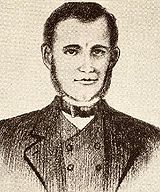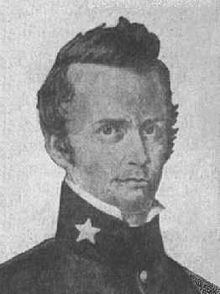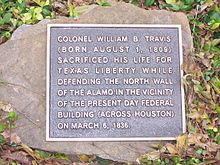- William B. Travis
-
William Barret Travis
William B. Travis. This sketch by Wiley Martin is the only surviving likeness drawn during Travis's lifetime, although its accuracy has been questioned.[1]Born August 1, 1809
Saluda County, South CarolinaDied March 6, 1836 (aged 26)
The Alamo, San Antonio, TexasAllegiance  United States
United States
 Republic of Texas
Republic of TexasService/branch  Texas Army
Texas ArmyYears of service 1835 - 1836 Rank Lieutenant Colonel Commands held The Alamo Battles/wars 
Signature of William B. TravisWilliam Barret Travis (August 1, 1809 – March 6, 1836) was a 19th-century American lawyer and soldier. At the age of 26, he was a lieutenant colonel in the Texas Army. He died at the Battle of the Alamo during the Texas Revolution.
Contents
Family life
Travis, an American of English descent was born in Saluda County, South Carolina, to Mark and Jemima Travis in 1809; records differ as to whether his date of birth was the first or ninth of August, but his youngest brother James C. Travis, who was in possession of the Travis family Bible at the time of his statement, indicated that he was born on the first. When he was nine, his uncle Alexander Travis, a prominent Baptist preacher, called on his family to move to the town of Sparta in Conecuh County, Alabama, where he received much of his education.[2] He later enrolled in a school in nearby Claiborne, where he eventually worked as an assistant teacher.[3]
Travis then became an attorney and, at age 19, married one of his former students, 16-year-old Rosanna Cato (1812–1848), on October 26, 1828. The couple stayed in Claiborne and had a son, Charles Edward, in 1829.[3] Travis began publication of a newspaper that same year, the Claiborne Herald. He became a Mason, joining the Alabama Lodge No.3 - Free and Accepted Masons, and later joined the Alabama militia as adjutant of the Twenty-sixth Regiment, Eighth Brigade, Fourth Division.
His marriage soon failed for unknown reasons, Travis fled Alabama in early 1831 to start over in Texas, leaving behind his wife, son, and unborn daughter.[3] Travis and Rosanna were officially divorced by the Marion County courts on January 9, 1836, by Act no. 115. Their son was placed with Travis's friend, David Ayres, so that he would be closer to his father.
Rosanna married Samuel G. Cloud in Monroeville, Alabama, on February 14, 1836. They both died of Yellow Fever in 1848.
Texas
In May 1831, upon his arrival in Mexican Texas, a part of northern Mexico at the time, Travis purchased land from Stephen F. Austin and began a law practice in Anahuac. He played a role in the growing friction between American settlers and the Mexican government and was one of the leaders of the War Party, a group of militants opposed to Mexican rule. He became a pivotal figure in the Anahuac Disturbances, which helped to precipitate the war.[4]
The Texas Revolution began in October 1835 at the Battle of Gonzales. In November, Travis played a small role in the Siege of Bexar. On December 19, Travis was commissioned as a lieutenant colonel of the Legion of Cavalry and became the chief recruiting officer for the Texan army. His command was to consist of 384 men and officers, divided into six companies. Despite his rank, Travis had to recruit the men who were to serve under his command, but he had difficulty in finding willing colonists to enlist. "Volunteers can no longer be had or relied upon", he wrote to acting governor Henry Smith.
Smith ordered Travis to raise a company to reinforce the Texans at the Alamo Mission in San Antonio. Travis considered disobeying his orders, writing to Smith: "I am willing, nay anxious, to go to the defense of Bexar, but sir, I am unwilling to risk my reputation ... by going off into the enemy's country with such little means, so few men, and with them so badly equipped."[5]
On February 3 Travis arrived in San Antonio with eighteen men as reinforcements. On February 12, as the next highest ranking officer, Travis became the official commander of the Alamo garrison. He took command of the regular soldiers from Col. James C. Neill, of the Texan army. Neill had to leave to care for his ill family, but he promised to be back in twenty days. James Bowie (1795–1836) would command the volunteers as Travis commanded the regulars.[6]
The Mexican army, under dictator/General Antonio López de Santa Anna, began its attack on the mission on February 23, 1836. In a brief letter to the alcade of Gonzales, Andrew Ponton, Travis wrote:
- "The enemy in large force is in sight... We want men and provisions ... Send them to us. We have 150 men & are determined to defend the Alamo to the last."
In a letter to the Texas Convention on March 3: "...yet I am determined to perish in the defence of this place, and my bones shall reproach my country for her neglect."
In Travis' last letter out of the Alamo, March 3 to David Ayres:
- "Take care of my little boy. If the country should be saved, I may make him a splendid fortune; but if the country should be lost, and I should perish, he will have nothing but the proud recollection that he is the son of a man who died for his country."
There is a legend that, one to three days before the final Mexican assault, Travis gathered all of the Alamo's defenders in the main plaza of the fort. Announcing that reinforcements would not be coming, Travis unsheathed his sword and drew a line in the dirt. He then told those men who were willing to stay and die with him to cross the line; those who wanted to leave could do so without shame. Most of the Alamo's defenders subsequently crossed the line, leaving only two men behind. One soldier, Bowie, was confined to a cot with typhoid, but asked to be carried across the line. The other was a French veteran of the Napoleonic Wars named Moses Rose. Rose, who later declared, "By God, I wasn't ready to die," scaled a wall that night and escaped, thus preserving the story of Travis's line in the sand. This account was told by Rose to numerous people later in his life.
On March 6, 1836, following a thirteen-day siege, Travis, Bowie, David Crockett, and James Bonham were killed in a predawn attack along with about 188-250 other defenders during the Battle of the Alamo. The Mexicans overran the fort, surrounded it, used ladders to climb over the walls and broke down the fort's defenses. There are reports that Travis died early in the assault, of a single gunshot wound to the forehead while defending the north wall. Joe, a freed former slave to Travis, who was present during the final assault as a noncombatant, stated afterward that he saw Travis stand on the wall and fire into the attackers. He saw Travis shoot and kill a Mexican soldier climbing over the wall from a ladder, with Travis falling immediately afterward. This is the only dependable account of Travis' death.
When Santa Anna came into the fort he asked the alcalde of San Antonio, Francisco A. Ruiz, to identify the bodies of the rebel leaders to him. Ruiz later said that the body of Travis was found on a gun carriage on the north wall. Within a few hours of the final gunshots being fired, Santa Anna ordered a company of dragoons to gather wood and burn all the Texans' bodies. By five o'clock that evening, the bodies of Travis, Crockett, Bowie and Bonham were burned along with the other defenders.
Travis's famous letter from the Alamo
On February 24, 1836, during Santa Anna's siege of the Alamo, Travis wrote a letter addressed "To the People of Texas and All Americans in the World":
- Fellow citizens and compatriots;
- I am besieged, by a thousand or more of the Mexicans under Santa Anna. I have sustained a continual Bombardment and cannonade for 24 hours and have not lost a man. The enemy has demanded a surrender at discretion, otherwise, the garrison are to be put to the sword, if the fort is taken. I have answered the demand with a cannon shot, and our flag still waves proudly from the walls. I shall never surrender or retreat. Then, I call on you in the name of Liberty, of patriotism & everything dear to the American character, to come to our aid, with all dispatch. The enemy is receiving reinforcements daily and will no doubt increase to three or four thousand in four or five days. If this call is neglected, I am determined to sustain myself as long as possible and die like a soldier who never forgets what is due to his own honor & that of his country. Victory or Death.
- William Barret Travis
- Lt. Col. Comdt.
- P.S. The Lord is on our side. When the enemy appeared in sight we had not three bushels of corn. We have since found in deserted houses 80 or 90 bushels and got into the walls 20 or 30 head of Beeves.
- Travis
He gave this letter to courier John William Smith to deliver. The envelope that contained the letter was labeled "Victory or Death".[5] The letter, while unable to bring aid to the garrison at the Alamo, did much to motivate the Texan army and helped to rally support in America for the cause of Texan independence. It also cemented Travis's status as a hero of the Texas Revolution.
Chance for help
As late as March 3, Travis had every bit of optimism of reinforcements with the arrival of messenger James Bonham. He carried a letter from Robert M. "Three-Legged Willie" Williamson, which stated that help was coming in the form of 60 volunteers from San Felipe, 300 volunteers (and four cannons) from James Fannin, and another contingent of 300 volunteers by March 1. ( ...For God's sake hold out until we can assist you...")
The "line in the sand"
What is not disputed about the Battle of the Alamo is that by March 3, 1836, Travis understood the situation his garrison faced, and it was more than bleak; in fact, the situation was hopeless. It is alleged that he called the troops of his garrison together either on that day or on March 4, 1836, and told them, "We must die. Our business is not to make a fruitless effort to save our lives, but to choose the manner of our death." With that, taking example from "the 13 of the Fame" act done by Francisco Pizarro a couple of centuries before, it is alleged he made a sweep with his sword and drew a line in the sand, asking all who would stay to cross it and those not willing not to cross it. Only Moses Rose, a French-born former soldier in Napoleon Bonaparte's Grande Armée, did not cross. Rose has since been known as the Coward of the Alamo.[7]
It is a fact that Moses Rose, by his own later accounts, was the only soldier who chose to depart, which he did by sneaking through Mexican lines in the late-night hours of March 5, 1836. Allegedly, it was Rose who first said that Travis drew the line. Susannah Dickinson, widow of Alamo defender Capt. Almaron Dickinson, was present during the siege and battle and confirmed that this did happen. But no reliable written accounts support this. Whether or not Travis actually did draw the line in the sand is still disputed. However, what is known, by Rose's own accounts, is that Travis did give the members of the garrison a choice of staying or going, and by Rose's own accounts only Rose chose the latter.[7]
Travis' children
Charles Edward Travis (1829–1860) was raised by his mother and her second husband. He won a seat in the Texas legislature in 1853. In 1855, he enlisted in the U.S. Army as a captain in a cavalry regiment (which was later renamed the 5th Cavalry Regiment (United States) commanded by Albert Sidney Johnston) but was discharged in May 1856 for "conduct unbecoming an officer and a gentleman" following an allegation that he had cheated at cards.[8]
He appealed the decision to no avail and then turned to studying law, earning a degree from Baylor University in 1859. He died of consumption (tuberculosis) within a year and is buried beside his sister.[9]
Susan Isabella Travis was born in 1831, after Travis had departed for Texas. Although her paternity has been questioned, Travis did name her as his daughter in his will. In 1850 she married a planter from Chapell Hill, and they had one daughter.
See also
Footnotes
- ^ McKeehan, Wallace L.. "Gonzales Alamo Relief Defenders". Sons of DeWitt Colony Texas. Texas A&M University. http://www.tamu.edu/ccbn/ccbn/dewitt/gonrelief.htm. Retrieved 2009-01-23.
- ^ Betty Smith Meischen (2003). Trails West: Book II the Trail to San Jacinto. iUniverse. pp. 44–45. ISBN 0595258972.
- ^ a b c Davis (1966), p. xii.
- ^ Davis (1966), p. xiv.
- ^ a b Hardin (1994), p. 117.
- ^ Davis (1966), p. xvi.
- ^ a b http://www.texasescapes.com/MikeCoxTexasTales/Line-in-the-Sand-Alamo-History.htm
- ^ Biographic sketch of Charles Edward Travis in the Handbook of Texas Online
- ^ Masonic Cemetery at Chappell Hill, TX
References
- Davis, Robert E. (1966). The Diary of William Barret Travis. Waco, Tx: Texian Press. ASIN B000MTTVP4
- Hardin, Stephen L. (1994). Texian Iliad. Austin, TX: University of Texas Press. ISBN 0-292-73086-1.
- Brief biography of Travis at Lone Star Junction
- Detailed biography from the Handbook of Texas Online
- Timeline of the life of William Barret Travis
- First Hand Alamo Accounts
Further reading
- Lord, Walter; A Time To Stand; University of Nebraska Press; ISBN 0-8032-7902-7
- Davis, William C. Three Roads to the Alamo; HarperCollins Publishers; ISBN 0-06-017334-3
- McDonald, Archie P.; William Barret Travis; Eakin Press; ISBN 0-89015-656-5
External links
- William Barret Travis from the Handbook of Texas Online
- Travis "Victory or Death" Letter at Texas Heritage Society
 "Travis, William Barrett". Appletons' Cyclopædia of American Biography. 1889.
"Travis, William Barrett". Appletons' Cyclopædia of American Biography. 1889.
Battle of the Alamo Siege Legacy Remember the Alamo (song) · The Alamo: Shrine of Texas Liberty (1938) · Davy Crockett, King of the Wild Frontier (1954) · The Last Command (1955) · The Alamo (1960) · The Alamo: Thirteen Days to Glory (1987) · The Alamo (2004)Defenders Texian survivors Mexican commanders See also Categories:- Military personnel killed in action
- Alamo defenders
- People from Conecuh County, Alabama
- People from Saluda County, South Carolina
- People from San Antonio, Texas
- 1809 births
- 1836 deaths
- American people of English descent
- People of the Texas Revolution
- Deaths by firearm in Texas
Wikimedia Foundation. 2010.




